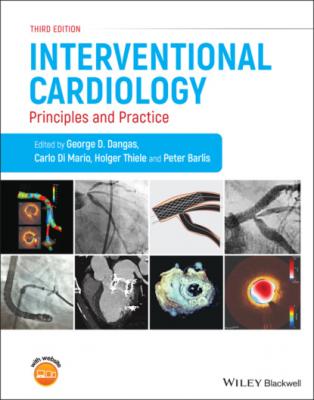Interventional Cardiology. Группа авторов
Читать онлайн.| Название | Interventional Cardiology |
|---|---|
| Автор произведения | Группа авторов |
| Жанр | Медицина |
| Серия | |
| Издательство | Медицина |
| Год выпуска | 0 |
| isbn | 9781119697381 |
Table 13.1 Key large‐cohort clinical trials involving 1st and subsequent generation drug‐eluting stents in STEMI.
| Study name | Description and Primary Endpoint | Result | n | Source |
|---|---|---|---|---|
| 1st generation | ||||
| TYPHOON | STEMI patients onlySirolimus eluting stents (Cypher) vs bare metal stents (BMS)Cardiac death, myocardial infarction or reintervention at 1 year | 7.3% in the in the sirolimus stent group vs 14.3% in the BMS group (p = 0.004) | 712 | NEJM 2006121 |
| PASSION | STEMI patients onlyPaclitaxel‐eluting stents vs BMSCardiac death, myocardial infarction or reintervention at 1 year | 8.8% in the paclitaxel‐stent group vs 12.8% in the BMS group (RR 0.63; 95% CI 0.37‐1.07; p = 0.09) | 619 | NEJM 2006122 |
| SESAMI | STEMI onlySirolimus‐eluting stents (Cypher) vs BMSAngiographic binary restenosis at one year (≥50% reduction of the initial lumen diameter in the target lesion) | 9.3% in the SES group vs 21.3% in the BMS group (p = 0.032) | 320 | JACC 2007123 |
| 2nd generation | ||||
| EXAMINATION | STEMI patients only2nd generation everolimus‐eluting stents (EES) vs BMSAll‐cause death, recurrent MI, target lesion or target vessel revascularization, stent thrombosis, device and procedure success, major and minor bleeding at 12 months/5 years | 11.9% in in EES group vs 14.2% in BMS group (p = 0.19). Target lesion and vessel revascularization, and stent thrombosis significantly lower in EES group.Reduced all‐cause mortality at 5 years in EES group. | 1504 | Lancet 2012124,125 |
| XAMI | STEMI patients only2nd generation EES vs 1st generation SESCardiac death, nonfatal MI, or any target vessel revascularization | 4.0% for EES vs 7.7% for SES (p = 0.048) | 625 | JACC 2012126 |
| COMFORTABLE‐AMI | STEMI patients onlyBiolimus‐eluting stents with biodegradable polymer vs BMSCardiac death, target vessel‐related infarction, and ischemia driven target‐lesion revascularization at one year | 4.3% in biolimus eluting stent group vs 8.7% in BMS (HR 0.49; 95% CI 0.3–0.8; p = 0.004) | 1161 | JAMA 2012 [127] |
| MASTER | 2nd generation biodegradable polymer sirolimus‐eluting stents (SES) vs bare metal stents in STEMIcardiac death, MI not clearly attributable to a non‐target vessel or clinically driven target vessel revascularization at 12 months | 6.1% in BP‐SES patients and 14.4% in BMS patients (p value for non‐inferiority 0.0004) | 500 | EuroIntervention 2019 [128] |
| 3rd generation | ||||
| BIOSCIENCE | Ultrathin‐strut, biodegradable‐polymer, sirolimus‐eluting stents versus thin‐strut, durable‐polymer, everolimus‐eluting stents in ACS and chronic angina patients (19% STEMI [129])Target lesion failure – composite of cardiac death, target vessel myocardial infarction and clinically indicated target lesion revascularization at 5 years | 20.2% in the biodegradable‐polymer sirolimus‐eluting stents and 18.8% in the durable‐polymer everolimus‐eluting stents (rate ratio 1.07; 95% CI 0.88–1.31; p = 0.487) | 2119 | The Lancet 2018 [130] |
| BIO‐STEMI | STEMI patients exclusivelyBiodegradable polymer sirolimus eluting stents (Orsiro) vs durable polymer everolimus‐eluting stents (Xience)Target lesion failure – cardiac death, target vessel myocardial reinfarction, clinically indicated target lesion revascularization at 12 months | 4% of patients with biodegradable sirolimus‐eluting stents and 6% of patients with durable polymer everolimus‐eluting stents (rate ratio 0.59, 95% CI 0.37–0.94, posterior probability of superiority 0.986) | 1300 | The Lancet 2019 [131] |
| MAGSTEMI | STEMI patients exclusivelyMagnesium based bioresorbable scaffold (MgBRS) vs permanent metallic sirolimus eluting stent (SES)Rate of increase after nitroglycerin of the mean lumen diameter of the in‐stent/scaffold segment at 12 months, as an assessment of endothelial‐independent vasomotor response | 56.5% for the MgBRS arm vs 33.8% for the SES arm, p = 0.010 | 150 | Circulation 2019 [132] |
It should be noted that the 2018 ESC guidelines [22] on myocardial revascularization do not recommend the use of bioresorbable vascular scaffolds (BVS) on the basis of the findings of clinical trials comparing the Absorb BVS and metallic everolimus‐eluting stents, as well as subsequent meta‐analyses, which showed an increased risk of target lesion failure and device thrombosis [23,24]. The ISAR‐ABSORB trial [25], suggested that more favorable results may be achieved in patients with acute MI (STEMI or non‐STEMI presentation), but the current recommendation is that this device only be used in the research setting.
ESC guidelines currently recommend stenting in the primary PCI setting with new‐generation DES over BMS [3]. AHA guidelines recommend placement of a DES or BMS, and advise BMS in patients who are unable to tolerate or comply with a prolonged course of DAPT [4]. This is, however, a recommendation based on evidence available at the time of writing the AHA guidelines in 2013, and there is a significant base of evidence established since then suggesting that a very short duration of DAPT may be acceptable in the setting of DES implantation. This is discussed in more detail in the section on antiplatelet therapy below.
Multivessel disease
Multivessel coronary artery disease is present in approximately 50% of STEMI patients, who have been shown to have poorer recovery of ejection fraction and higher mortality
